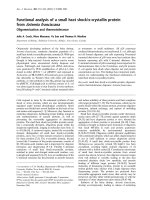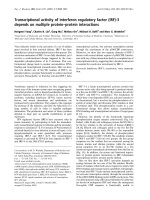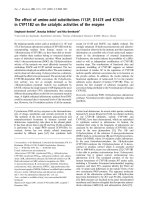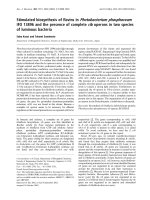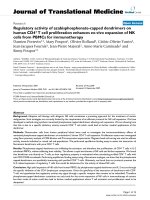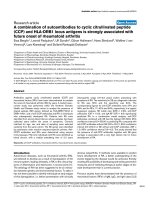Báo cáo Y học: Amidolytic activity of prostatic acid phosphatase on human semenogelins and semenogelin-derived synthetic substrates docx
Bạn đang xem bản rút gọn của tài liệu. Xem và tải ngay bản đầy đủ của tài liệu tại đây (206.42 KB, 6 trang )
Amidolytic activity of prostatic acid phosphatase on human
semenogelins and semenogelin-derived synthetic substrates
Miche
Á
le Brillard-Bourdet
1
, Sophie Re
Â
hault
1
, Luiz Juliano
2
, Miche
Á
le Ferrer
1
, Thierry Moreau
1
and Francis Gauthier
1
1
Laboratory of Enzymology and Protein Chemistry, INSERM EMI-U 00-10, University FrancË ois Rabelais, Faculty of Medicine,
Tours, France;
2
Departamento de Biofõ
Â
sica, Escola Paulista de Medicina, Universidade Federal de Sa
Ä
o Paulo, Sa
Ä
o Paulo, Brazil
In addition to kallikrein hK3, a serine protease generally
reported as PSA (prostate-speci®c antigen), at least two
other enzymes in human seminal plasma also cleave syn-
thetic peptidyl substrates derived f rom the sequen ce o f
human semenogelins. We have identi®ed one of these a s
prostatic acid phosphatase (PAP), a major component of
prostatic ¯uid whose physiological function is unclear. T he
other is a high M
r
basic protein present at low concentrations
in seminal plasma and that remains to be characterized. PAP
was puri®ed to homogeneity from freshly ejaculated seminal
plasma. Its N-terminal sequence a nd its phosphatase prop-
erties (hydrolysis of p ara-nitrophenylphosphate at low p H)
were determined, and its inhibition by sodium ¯uoride
measured. Both puri®ed and c ommercial PAP also had
amidolytic activity on peptide substrates derived from the
semenogelin sequence a t neutral and slightly basic pH. The
k
cat
/K
m
values w ere in t he 10
2
)10
3
M
)1
ás
)1
range u sing
¯uorogenic semenogelin-derived substrates whose peptidyl
moiety included cleavage sites that had been identi®ed
ex vivo. PAP cleavage sites d iered fro m those of hK3 and
were mainly at P1 Gln residues or b etween residues
bearing hydroxyl groups. PAP amidolytic activity was
poorly inhibited by all currently used wide spectrum
proteinase inhibitors. Only 3±4 dichloroisocoumarin and
benzamidine inhibited puri®ed PAP. Puri ®ed human s eme-
nogelin was cleaved by puri®ed and commercial PAP at
neutral p H; the two ma in cleav age sites were at Tyr292 and
Ser170 (semenogelin I sequence), only the former has been
identi®ed ex vivo by analysis of seminal plasma.
Keywords: amidolytic activity; ¯uorogenic substrates;
human kallikrein; phosphatase; semenogelins.
The s emenogelins I and II are secreted by the s eminal
vesicles into human semen where they immediately form a
coagulum that entraps spermatozoa upon ejaculation. This
coagulum dissolves within a few minutes after ejaculation as
a result of proteolysis involving kallikrein hK3 (prostate-
speci®c antigen, PSA) [1,2]. This appears to be the main
physiological function of this protease, although it may act
on several other biological substrates, such as insulin-like
growth factor binding proteins [3±5] and parathyroid
hormone-related protein [6].Exvivoanalysis by two-
dimensional electrophoresis of fresh ejaculates i denti®ed
preferential cleavage sites in semenogelins at Tyr136, Tyr292
and Gln266 of semenogelin I (S. Re
Â
hault & M. Brillard-
Bourde t,
3
unpublished data). All three cleavage sites have
been identi®ed by in vitro studies [7], the third one only very
recently [8]. W e prepared peptidyl ¯uorogenic substrates of
hK3 based on these sequences and on others containing
previously identi®ed cleavage sites, in an attempt to obtain
more sensitive substrates o f hK3 than those that a re
available c ommercially. Some of them were cleaved by at
least two other proteases obtained by ion exchange chro-
matography from crude seminal plasma. This study shows
that one of these enzymes is prostatic acid phosphatase
(PAP), although this enzyme has never been attributed any
proteolytic or amidolytic activity to date. L arge amounts of
PAP (1 mgámL
)1
) are present in seminal ¯uid [9], but its
physiological function remains unclear even its cellular form
has neutral protein-tyrosine kinase phosphatase activity
[10].
We have puri®ed PAP to homogeneity and compared its
amidolytic properties to those of commercial source using
semenogelin-derived ¯uorogenic and puri®ed semenogelins.
MATERIALS AND METHODS
Materials
The following materials were obtained from commercial
sources: DEAE±Sephadex A50, Seph acryl S300,
Phenyl-Sepharose (Pharmacia), NaF, (Octylphenoxy) poly-
ethoxyethanol (IGEPAL
4
CA-630 Sigma), EDTA, dimethyl-
formamide, acetonitrile (Merck), CF
3
COOH
5
(Perkin
Elmer). All other reagents were of analytical grade. Com-
mercial PAP puri®ed from human semen was from Sigma.
Puri®cation and characterization of PAP
Approximately 50 mL of seminal plasma was obtained from
healthy donors, dialysed against 3 ´ 2L25m
M
Tris/HCl
Correspondence to F. Gauthier, Laboratory of Enzymology and
Protein Chemistry, INSERM EMI-U 00-10, University FrancË ois
Rabelais, Faculty of Medicine, 2 bi, Boulevard Tonnelle
Â
,
37032 Tours cedex France. Fax: + 33 2 47 36 60 46,
E-mail:
Abbreviations: PSA, prostate-speci®c antigen; PAP, prostatic acid
phosphatase; DCI, 3-4 dichloroisocoumarin
1,2
;IGEPAL
1,2
,
(octylphenoxy) polyethoxyethanol; Abz, O-aminobenzoyl;
EDDnp, ethylenediamine 2,4-dinitrophenyl.
(Received 23 July 2001, revised 31 October 2001,
accepted 9 Nove mber 2001)
Eur. J. Biochem. 269, 390±395 (2002) Ó FEBS 2002
pH 7.8, 0.15
M
NaCl, and fractionated on DEAE A50. The
column (2.6 ´ 40 cm) was washed with 200 mL equilibrium
buffer and proteins were eluted at 28 mLáh
)1
with a
discontinuous gradient of NaCl (25 m
M
,80m
M
,and
200 m
M
). Fractions were assayed for their enzymatic
activity towards Abz-ISYQSSSTEEQ-EDDnp as reported
under Kinetic measurements. Fractions that were eluted
from DEAE A50 w ith 200 m
M
NaCl were fractionated
further on Sephacryl S300. The column (2.6 ´ 100 cm) was
equilibrated in t he same buffer a s before and eluted at
60 mLáh
)1
. Fractions of the s econd eluted peak were
pooled, checked for activity towards the same substrate as
before, and run onto a phenyl-Sepharose column (1 ´ 7cm)
equilibrated with 25 m
M
Tris/HCl pH 7.8, 1.5
M
(NH4)
2
SO
4
. The column was eluted with a decreasing d iscontin-
uous gradient of ammonium sulfate. Enzymatically active
fractions were concentrated and checked for purity by four
methods. First, HPLC on C4 (C4 uptisphere column, 5 lm,
30 mm ´ 2.1 mm) eluted with a linear gradient of aceto-
nitrile (0±60%, v/v) in 0.075% CF
3
COOH for 40 min at a
¯ow rate of 0.2 mLámin
)1
; second MALDI-TOF MS using
aBru
È
cker Re¯ex mass spectrometer; third SDS/PAGE and
fourth N-terminal sequencing. The protein concentration
was calculated from a BCA assay and the activity is
expressed with reference to the phosphatase activity of
commercial PAP.
Puri®cation of human semenogelins
Semenogelins were p uri®ed essentially as described by
Malm et al. with some modi®cation s [11]. Ejaculates from
healthy volunteers were collected on DEAE cellulose A50
equilibrated in 40 m
M
Tris/HCl pH 9.7 in the presence of
4
M
urea and a cocktail of inhibitors. T here was no
signi®cant degradation of semenogelins under these condi-
tions, which allow the rapid separation by centrifugation of
cellular components and gel-bound proteases. The ®nal step
of puri®cation was HPLC fractionation on a C4 column
using a 0±60% (v/v) linear gardient of acetonitrile in 0.075%
CF
3
COOH for 40 min at a ¯ow rate of 0.2 mLámin
)1
.
Synthesis of ¯uorogenic substrates
The intramolecularly quenched ¯uorogenic peptides were
synthesized by solid-phase method; glutamine was the
C-terminal residue of all peptides due to a requirement of
the synthesis strategy [12]. All syntheses were performed
with Fmoc methodology using a multiple automated
peptide synthesizer (PSSM-8, Shimadzu Co.). Intramolec-
ularly quenched ¯uorogenic substrates were prepared as
2m
M
stock solutions in dimethylformamide and diluted
with activation buffer . Substrate purity w as checked by
MALDI-TOF MS (TofSpec-E, Micromass) and by re-
versed-phase chromatography on a C18 column eluted with
a 10-min linear gradient of 0±60% acetonitrile in 0.075%
CF
3
COOH at 0.5 mLámi n
)1
.
Kinetic measurements
All amidolytic assays were carried out at 37 °Cin20m
M
Tris/HCl pH 9.0. Speci®city constants (k
cat
/K
m
)were
determined for Abz-peptidyl-EDDnp substrates under
pseudo-®rst order conditions, using a substrate concentra-
tion far below the K
m
, as reported elsewhere [13]. Calcula-
tions were done usin g
ENZFITTER
software (Biosoft).
Excitation and emission wavelengths were 320 nm and
420 nm for e xperiments with intramolecularly quenched
¯uorogenic substrates. The system was standardized using
Abz-FR-OH prepared by total tryptic hydrolysis of Abz-
FR-pNA, and its concentration was determined from the
absorbance at 410 nm, assuming e
410nm
8800
M
)1
ácm
)1
for p-nitroanilide. Substrate concentrations of Abz-pept-
idyl-EDDnp were determined by measuring the absor-
bance at 365 nm, assuming e
365nm
17 300
M
)1
ácm
)1
for
EDDnp. K
m
s were measured using six substrate concentra-
tions (0.2±12 l
M
), the ®nal concentration of PAP was in the
0.1 l
M
range. The phosphatase activity of the puri®ed PAP
was measured using p-nitrophenylphosphate as substrate
and the method recommended by the manufacturer
(Sigma). This activity was compared to that of commercial
PAP and the concentration of a ctive enzyme calculated on
this basis.
The pH activity pro®les were determined by measuring
the phosphatase and the peptidase activities of puri®ed PAP
over the pH range 3±10 at 0.5 unit intervals at 37 °C. 20 m
M
citrate/phosphate buffers were used over the pH range 3±7,
20 m
M
phosphate buffer for p H 7±8, 20 m
M
Tris/HCl for
pH 8±9 and 20 m
M
carbonate/bicarbonate buffer for pH 9±
10. All other experimental cond itions were as reported
above.
Inhibition of puri®ed PAP
The amidolytic activity of puri®ed PAP (60 n
M
®nal) was
measured in the presence of a molar excess of inhibitors
from all four classes of proteases ) aprotinin, benzamidine,
leupeptin, Soya bean t rypsin inhibitor (SBTI)
6,7
,(1-trans-
epoxysuccinyl-leucylamido (4-guanidino) butane (E64
6,7
),
o-phenanthroline, and NaF, w hich inhibits phosphatase
activity [14]. Inhibitors were mixed with the enzyme for
15minin20m
M
Tris/HCl pH 9.0, 0.0 5% IGEPAL at
37 °C, before adding the ¯uorogenic substrate ( 2 l
M
).
Inhibition is expressed with reference to an inhibitor-free
control incubated under the same experimental conditions.
Conversely, acid phosphatase activity was measured in
the presence of NaF and of those of inhibitors that alter
amidolytic activity. Incubation with inhibitors was per-
fromed at pH 9 and at pH 4.8, befo re the PAP activity was
measured at pH 4.8. The in¯uence of ¯uorogenic substrate
binding on phosphatase activity was also assayed by
incubating PAP with A bz-SSIYSQTEEQ-EDDnp (2 l
M
and 20 l
M
®nal) under the same experimental conditions
and then measuring phosphatase activity.
Identi®cation of cleavage sites in peptidyl substrates
Fluorogenic peptides (15±30 l
M
®nal) were incubated with
puri®ed PAP in the 0.1 l
M
range at 37 °Cin20m
M
Tris/HCl pH 9.0 containing 0.02% IGEPAL. Aliquots
(200 lL) were removed at intervals up to 60 min and the
reaction was blocked by adding 4 lLCF
3
COOH. T he
samples were fractionated on a C18 cartridge column
(5 lm, 30 mm ´ 2.1 mm) using a linear gradient of
acetonitrile (0±60%, v/v) in 0.075% CF
3
COOH for
10 min at a ¯ow rate of 0.5 mLámin
)1
, with simultaneous
recordings at three wavelengths ( 220, 320, and 360 nm).
Ó FEBS 2002 Amidolytic activity of prostatic acid phosphatase (Eur. J. Biochem. 269) 391
This allowed direct identi®cation of EDDnp-containing
peptides prior to N-terminal sequencing of all signi®cant
peaks.
Amino acid sequence analysis of peptide products
The amino-acid sequen ces were determined using an
Applied Biosystems 477A pulsed liquid sequencer with the
chemicals and program recommended by the manufacturer.
Phenylthiohydantoin derivatives were identi®ed using an on
line model 120A PTH a nalyser.
RESULTS AND DISCUSSION
Sperm lique®es very rapidly after ejaculation due to the
proteolytic cleavage of the coagulum-forming proteins
semenogelins I and II. This results in the progressive release
of motile spermatozoa and also in the generation of
biologically active semenogelin fragments, the function of
which is not yet fully understood [7,15]. Kallikrein hK3 has
long been described as t he protease responsible for this
proteolysis, based on its high concentration in seminal
plasma and o n its chymotrypsin-like s peci®city. It thus
cleaves puri®ed semenogelins mainly at tyrosine residues,
although cleavage may also occur at histidine and glutamine
residues after prolonged incubation of puri®ed semenogelins
with hK3 [7,8]. However, total ex vivo hydrolysis of
semenogelins is completed within minutes following ejacu-
lation, suggesting that some other proteases participate to
this process. We have prepared an intramolecularly
quenched ¯uorescent substrate (Abz-ISYQSSSTEEQ
EDDnp) that encompasses a sequence containing a major
ex vivo cleavage site, the Gln266±Ser267 bond of semenog-
elin I (S. Re
Â
hault & M. Brillard-Bourdet, unpublished
data)
8
. This cleavage site has been also recently identi®ed in
puri®ed semenogelins after extensive cleavage by hK3 [8],
although it was initially reported to be one residue upstream
in this sequence, at the Tyr265±Gln266 bond [7]. Hydrolysis
of this substrate by samples from the fractionation of
seminal plasma on an anion exchanger revealed two
fractions that c leaved this peptide, one eluting with t he
ionic strength used for PSA/hK3, and the other, with a
much lower pHi, with the buffer containing 200 m
M
NaCl
(Fig. 1A). This s econd peak was fractionated further by gel
chromatography (Fig. 1 B), to give two peaks with amido-
lytic activity, one was eluted in the void volume and the
other in the 50±100 kDa fractions. Semen thus contains at
least three proteases that have amidolytic activity on this
semenogelin-derived substrate. They had different substrate
speci®cities; hK3 cleaved at the tyrosine±glutamine bond,
whereas the Sephacryl S300-excluded fraction cleaved at the
glutamine±serine bond and the ®ltered fraction at the
serine±tyrosine bond, as shown by HPLC fractionation and
N-terminal sequencing. Part of the last ®ltered fraction was
puri®ed further by hydropho bic chromatography on phe-
nyl-Sepharose. Fractions with enzymatic activity were
analysed by MALDI TOF MS and reversed-phase HPLC
on a C4 cartridge. A molecular mass of 47 798 Da was
determined by MS and a single, symetrical peak was eluted
from the C4 column (Fig. 1C). The collected fraction was
immediately equilibrated in n eutral buffer to d etermine
residual peptidase activity. Its N-terminal sequence (20
residues) was 100% identical to PAP and showed no trace
of contamination. This fraction still had enzymatic activity
on Abz-ISYQSSSTEEQ-EDDnp when buffered at neutral
pH immediately after elution from the C4 cartridge,
demonstrating that the sequenced product and that with
peptidase activity were the same. The puri®ed enzyme was
checked for its phosphatase activity on p-nitrophenyl
phosphate and this activity w as compared to that of
commercial PAP. Based on a molar concentration of about
9 l
M
estimated from a BCA protein assay for the PAP
monomer, a value of 1.67 p hosphatase unitsánmol
)1
was
calculated for puri®ed PAP, which is in the same range as
that reported for commercial PAP. Con®rmation that PAP
had amidolytic activity was obtained by showing that
commercial PAP hydrolysed the Abz-ISYQSSSTEEQ-
EDDnp substrate at neutral pH, as does the puri®ed
enzyme. The ratio of the amidolytic activity of puri®ed to
that of commercial PAP (2.5) was also in agreement with
that obtained by measuring phosphatase activity (1.75).
PH-dependence of PAP amidolytic activity
The pH-dependence of PAP amidolytic activity was studied
over the pH range 3±9. The Abz-ISYQSSSTEEQ-EDDnp
substrate was not hydrolysed at acidic pH, at which
phosphatase activity is greatest (Fig. 2). There was amido-
lytic a ctivity at n eutral pH, w ith a maximum at about
pH 9.0.
Inhibition of PAP amidolytic activity
A series of inhibitors of all classes of enzymes were tested for
their ability t o inhibit PAP. Only 3±4 dichloroisocoumarin
(DCI;
9
200 l
M
®nal) and benzamidine (0.5 m
M
®nal)
partially inhibited PAP amidolytic activity under the
experimental conditions used. Pepstatin, leupeptin,
PhCH
2
SO
2
F, SBTI, E64 and EDTA did not signi®cantly
inhibit PAP amidolytic activity. However, NaF (10 m
M
),
which strongly inhibits phosphatase activity at acidic pH,
inhibited PAP amidolytic activity at neutral pH. Converse-
ly, DCI and benzamidine partially inhibited phosphatase
activity (data not shown).
Incubating the substrate A bz-SSIYSQTEEQ-EDDnp
with puri®ed or commercial PAP at basic or acidic pH also
resulted in the inhibition of phosphatase activity, demon-
strating that the ¯uorogenic substrate, although not cleaved
at pH 4.6, binds to th e e nzyme active site under t hese
conditions.
PAP amidolytic activity on semenogelin-derived
substrates
The amidolytic activity of PAP was assayed u sing four
¯uorogenic substrates based on the ex vivo cleavage sites of
semenogelin I (S. Re
Â
hault & M. Brillard-Bourdet, unpub-
lished data)
10
. Those sites are at Tyr136, Tyr292 and Gln326
and all three have been identi®ed as putative hK3/PSA
cleavage sites [ 8]. T wo of these substrates included the
Gln326±Ser327 site, but within two different peptides
corresponding to residues 321±329 (substrate 3) or 323±
332 (substrate 4) of the semenogelin I sequence. The peptide
containing Tyr136 (peptide 1) was cleaved at the glutamine±
tyrosine bond by puri®ed PAP and the peptide containing
Tyr292 (peptide 2) was cleaved at the glutamine±threonine
392 M. Brillard-Bourdet et al. (Eur. J. Biochem. 269) Ó FEBS 2002
bond, with a s econd cleavage after tyrosine. PAP also
preferentially cleaved after a glutamine residue, at the
glutamine±serine bond in Abz-NKISYQSSSQ-EDDnp,
and secondarily at tyrosine±glutamine (Table 1). Speci®city
constants (k
cat
/K
m
) were measured under ®rst-order condi-
tions (Table 1). They indicated a rather low c leaving
ef®ciency, even though there was a tight interaction between
PAP and Abz-peptidyl-EDDnp substrates, as deduced from
the low values of K
m
in the micromolar range for substrate 1
(0.23 l
M
) and substrate 4 (4 l
M
) which are the only two
having a single cleavage site.
A shift in PAP speci®city w as observed depending on the
length and/or the nature o f the pep tidyl moiety in the
substrate. This occurred with substrate 4, whose cleavage
site is shifted towards the serine±tyrosine bond when the
N-terminal asparagine±lysine dipeptide was removed from
substrate 3. This phenomenon, which demonstrates the
in¯uence of surrounding subsites on P1 occupancy, was also
reported by Coombs et al. [16] for hK3/PSA hydrolysing
Fig. 1. Puri®cation of prostatic acid phosphatase from human seminal plasma. (A) SDS/PAGE of the 200 m
M
NaCl elution from the DEAE A50
column equilibrated in 25 m
M
Tris/HCl pH 7.8. Lane 2 shows a sample from the 80 m
M
NaCl elution containing hK3/PSA (M
r(app)
33 kDa).
(B) The 200 m
M
NaCl-eluted fractions were pooled, fractionated on Sephacryl S300, checked for their amidolytic activity (dashed line) and those
corresponding to the shaded area (lanes 1±3 on SDS/PAGE) wer e puri®ed further by h ydrophobic chromatography on phenyl-Sepharose .
(C) Phenyl-Sepharose fractions were pooled and checked for purit y by SDS/PAGE and C4 reversed-phase chromatography using a gradien t of
0±60% acetonitrile in 0.075% CF
3
COOH.
Fig. 2. pH activity pro®le of PAP activity (full line) and PAP amidolytic
activity (dashed line). Resul ts are norm aliz ed rates and ar e the means of
two experiments at each pH .
Ó FEBS 2002 Amidolytic activity of prostatic acid phosphatase (Eur. J. Biochem. 269) 393
peptide substrates. Nevertheless the preferential cleavage
sites for PAP in the p eptides used here were with glutamine
at P1 and hydroxyl-bearing (Ser, Thr, Tyr) residues at P1¢.
We do not know why PAP has amidolytic activity at neutral
pH. But its speci®city differs from that of hK3/PSA, which
also cleaves these substrates, but at different sites (S. Re
Â
hault
& M. Brillard-Bourdet, unpublished data)
11
.Wefurther
con®rmed that enzymatic activity of the PAP preparation is
not due to the presence of trace amounts of hK3 by showing
that: (a) the hK3 substrate Suc-AAPF-pNa is not cleaved
by PAP at a 1 l
M
®nal concentration; (b) a polyclonal
antibody against PSA does not reveal any band after
immunoblotting; (c) the amidolytic activity is strictly
associated with the peak of PAP after reversed-phase
HPLC, and no trace of contaminant at the elution time of
PSA was observed; (d) commercial PAP has amidolytic
activity similar to that of puri®ed PAP.
The fact that there was a shift in the cleavage of synthetic
peptides by PAP raised the question of whether PAP cleaves
a protein substrate such as semenogelin, which also
questions the biological relevance of PAP amidolytic
activity. We therefore measured the ability of pu ri®ed and
of commercial PAP to cleave freshly prepared semeno-
gelin I, and we identi®ed the main cleavage sites in the
protein.
PAP proteolytic activity on puri®ed semenogelins
Semenogelins were puri®ed from seminal plasma in such a
way that no proteolysis could occur upon sample collection.
Puri®ed semenogelin I was checked for purity by reversed-
phase HPLC, and used as a substrate for puri®ed and for
commercial PAP. PAP ( 1 l
M
®nal) was incubated with
puri®ed semenogelin 1 (16 l
M
®nal) for 18 h at 37 °Cin
20 m
M
Tris/HCl pH 9.0, 0.05% IGEPAL. The mixture was
then fractionated b y H PLC o n a C4 column, a nd the
cleavage sites identi®ed by N-terminal sequencing (Fig. 3).
Two cleavage sites were identi®ed, one at Ser170 and the
other at Tyr292. The former has not been described before,
whereas the latter is a m ajor cleavage site for hK3 [8].
Tyr292 is also present in substrate 2 used in this study
(Table 1). It is cleaved by PAP at the Tyr292±Ser bond and
at the Gln294±Thr bond, suggesting that accessibility to t he
sensitive bond is different in the peptide substrate and in the
protein.
Semenogelin was hydrolysed by a PAP concentration
lowerthanthatinthe10
)5
M
range found in semen [9].
Only a few sites were identi®ed however, and the exte nt of
proteolysis was lower than that obtained with hK3 under
similar conditions (data not shown). N evertheless, pros-
tatic P AP could b e i nvo lved i n s emenogelin processing
and d egradation because of its high concentration in
seminal plasma, its rather wide substrate speci®city, with
cleavage after glutamine or hydroxylated residues, and its
relatively slow inactivation in semen. The rapid hydrolysis
of semenogelin by hK3/PSA gives large fragments that
could be further processed by PAP, which is stable as a
protease at neutral pH, and whose phosphatase activity
requires an acid environment. This condition occurs
physiologically only when the enzyme reaches the female
genital tract [17].
ACKNOWLEDGEMENTS
The authors are indebted to C. Barthe
Â
le
Â
myandM.H.Saussereau
(Department of Human Reproduction CHRU Bretonneau, Tours) for
their collaboration and helpful advice, and in Brazil to the FundacË a
Ä
ode
Amparo a Pesquisa do Estado de Sa
Ä
o Paulo (FAPESP). The English
text was checked by Amanu ensis Scienti®ca.
REFERENCES
1. Lilja, H. (1985) A kallikrein-like serine protease in prostatic ¯uid
cleaves the predominant seminal vesicle protein. J. Clin. Invest. 76,
1899±1903.
2. Lilja, H., Oldbring, J., Rannevik, G. & Laurell, C.B. (1987)
Seminal vesicle-secreted proteins and their reactions during
gelation and liquefaction of human semen. J. Clin. Invest. 80,281±
285.
3. Rehault, S., Monget, P., Mazerbourg, S., Tremblay, R., Gutman,
N., Gauthier, F. & Moreau, T. (2001) Insulin-like growth factor
binding proteins (IGFBPs) as potential physiological substrates
for human kallikreins hK2 and hK3. Eur. J. Biochem. 268, 2960±
2968.
4. Cohen, P., Graves, H.C., Peehl, D.M., Kamarei, M., Giudice,
L.C. & Rosenfeld, R.G. (1992) Prostate-speci®c antigen (PSA) is
an insulin-like growth factor binding pro tein-3 protease fo und in
seminal plasma. J. Clin. Endocrinol. Metab. 75, 1046±1053.
Fig. 3. Hydrolysis of puri®ed semenogelin I by PAP. HPLC fraction -
ation on C4 of semenogelin incubates with (solid line) or without
(dashed line) puri®ed PAP. All m ajor fractions were sequenced
N-terminally to identify two cleavage sites, one at Ser170 (peak 1) and
one at Tyr292 (peak 2). The main peak on each chromatogram was the
IGEPAL and the last peak eluted was PAP.
Table 1 . Second order rate constants (k
cat
/K
m
) for the hydrolysis of
semenogelin-derived synthetic peptidyl substrates by puri®ed prostatic
acid phosphatase. k
cat
/K
m
values were determined under pseudo-®rst
order conditions. The results are the mean of two recordings for each
substrate. Cleavage sites are identi®ed after numbered residues i n
peptide sequences. Numbers refer to the positioning of the residue in
the human smenogelin I s equenc e.
Substrate k
cat
/K
m
(
M
)1
ás
)1
)
1 Abz-SSQ
135
YSNTEEQ- EDDnp 303
2 Abz-SSIY
292
SQ
294
TEEQ-EDDnp 600
3 Abz-NKISY
325
Q
326
SSSQ-EDDnp 1028
4 Abz-IS
324
YQSSSTEEQ-EDDnp 250
394 M. Brillard-Bourdet et al. (Eur. J. Biochem. 269) Ó FEBS 2002
5. Sutkowski, D.M., Goode, R.L., Baniel, J., Teater, C., Cohen, P.,
McNulty, A.M., Hsiung, H.M., Becker, G.W. & Neubauer, B.L.
(1999) Growth regu lation of prostatic stromal cells by prostate-
speci®c antigen [in process citation]. J. Natl Cancer Inst. 91, 1663±
1669.
6. Iwamura, M., Hellman, J., Cockett, A.T., Lilja, H. & Gershagen,
S. (1996) Alteration of the ho rmonal bioactivity of parathyroid
hormone-related protein (PTHrP) as a result of limited proteolysis
by prostate-speci®c antigen. Urology 48, 317±325.
7. Robert, M., Gibbs, B.F., Jacobson, E. & Gagnon, C. (1997)
Characterization of prostate-speci®c antigen proteolytic activity
on its major physiological substrate, the sperm motility inhibitor
precursor/semenogelin I. Biochemistry 36, 3811±3819.
8. Malm, J., Hellman, J., Hogg, P. & Lilja, H. (2000) Enzymatic
action of prostate-speci®c an tigen (PSA or hK3): substrate speci-
®city and regulation by Zn
2+
, a tight-binding inhibitor [in process
citation]. Prostate 45, 132±139.
9. Ronnberg, L., Vihko, P., Sajanti, E. & Vihko, R. (1981) Clom-
iphene citrate administration to normogonadotropic subfertile
men: blood hormone changes and activation of acid phosphatase
in seminal ¯uid. Int. J. Androl. 4, 372±378.
10. Meng, T.C. & Lin, M.F. (1998) Tyrosine phosphorylation of
c-ErbB-2 is regulated by the cellular form of prostatic a cid
phosphatase in human prostate cancer cells. J. Biol. Chem. 273,
22096±22104.
11. Malm, J., Hellman, J., Magnusson, H., Laurell, C.B. & Lilja, H .
(1996) Isolation and charac terization of the major gel proteins in
human semen, semenogelin I and semenogelin II. Eur. J. Biochem.
238, 48±53.
12. Hirata, I.Y., Cezari, M.H.S., Nakaie, C.R., Boschcov, P., Ito, A.S.
& Juliano, M.A. (1994) Internally quenched ¯uorogenic
protease substrates: solid phase synthesis and ¯uorescence
spectroscopy of peptides containing ortho-aminobenzoyl/ dinitro-
phenyl groups as d onor-accepto r pairs. L ett. Pept. Sci. 1, 299±
308.
13. Bourgeois, L., Brillard-Bourdet, M., Deperthes, D., Ju liano, L.,
Tremblay, R., Dube
Â
, J .Y. & Gauthier, F. (1997) Serpin-derived
substrates for investigating the substrate speci®city of human
tissue kallikreins hK 1 and hK2. J. Biol. Chem. 272, 29590±
29595.
14. NagDas, S.K. & Bhattacharyya, A.K. (1984) The kinetics of
inhibition of human seminal plasma acid phosphatase b y sodium
¯uoride. Biochem. Int. 9, 659±668.
15. Robert, M. & Gagnon, C. (1999) Semenogelin I: a coagulum
forming, multifunction al seminal vesicle protein. Cell Mol. Life
Sci. 55, 944±960.
16.Coombs,G.S.,Bergstrom,R.C.,Pellequer,J.L.,Baker,S.I.,
Navre, M., Smith, M.M., Tainer, J.A., Madison, E.L. & Corey,
D.R. (1998) Substrate speci®city of prostate-speci®c antigen
(PSA). Chem. Biol. 5, 475±488.
17. Ramsey, P.S., Ogburn, P.L., Harris, D.Y., Heise, R.H. & Ramin,
K.D. (2000) Eect of vaginal pH on ecacy of misoprostol for
cervical ripening and labor induction. Am. J. Obstet. Gynecol. 182,
1616±1619.
Ó FEBS 2002 Amidolytic activity of prostatic acid phosphatase (Eur. J. Biochem. 269) 395
